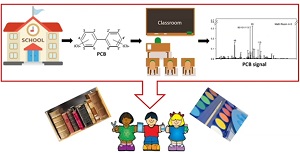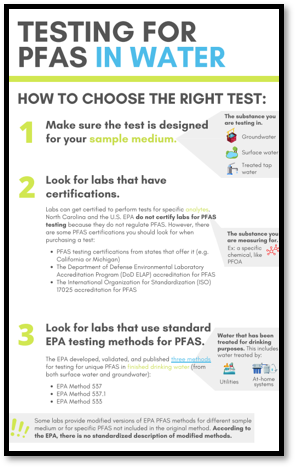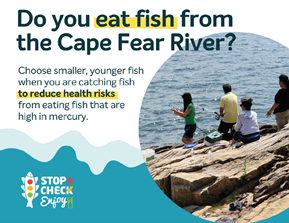Features
Risk Communication
Getting science into the hands of people who can use it is an essential element of the NIEHS Superfund Research Program (SRP). SRP grantees have developed materials to explain scientific research and provide communities with information to make health-protective decisions. With this in mind, SRP hosted a Risk Communication Strategies to Reduce Exposures and Improve Health workshop, June 21-22. SRP-funded researchers and their partners shared how they have engaged with local groups and communicated potential health risks (406KB) to reduce exposures and improve health.
This feature provides examples of products developed to move SRP-funded research beyond scientific journals and into tangible products for specific audiences. You can also learn more about these projects and other strategies to communicate potential environmental health risks to reduce exposures and improve health at the upcoming SRP Risk e-Learning webinar series, which will kick off September 24.
Designing Culturally Appropriate Messages

Communicating and working with Native American communities requires two-way communication strategies that build trust and value traditional knowledge and experiences. The University of New Mexico SRP Center works with Navajo Nation communities to understand their concerns and provide education on health risks associated with uranium mines.
Researchers mapped the environmental health risk of uranium contamination from abandoned mines on the Navajo Nation and are exploring zinc supplementation as a strategy to lessen the harmful effects of metal exposures on the immune system. To communicate these complex environmental health concepts, they collaborate with local artist-in-residence Mallery to share research findings through tribal art and symbolism.
Scientists at the University of California (UC), Davis SRP Center shared challenges, learning, and progress related to their collaboration with the Yurok Tribal Environmental Program. They have been working to evaluate contamination in the Klamath Watershed and understand unique routes of exposure. Yurok community members contribute expert knowledge regarding the history of the landscape, past scientific findings specific to the area, and potential exposure pathways that may be unique to tribal members. For example, they may be exposed to some contaminants while using culturally important plants that are ingested, inhaled, or handled, which are not typically considered for the general population. In addition to measuring chemical exposures to shed light on potential health risks, researchers have been working to develop meaningful two-way communication strategies between the university, tribal researchers, and other community partners. These strategies, such as recognizing tribal expertise and knowledge, will help empower communities to address their environmental health problems and provide training for scientists on developing equitable, respectful, and responsible projects with community partners.
Researchers from the Massachusetts Institute of Technology (MIT) SRP Center and the Sipayik Environmental Department, a tribal government department, partnered to co-launch a participatory science project to analyze municipal and private well drinking water quality in local households. Their objective was to provide households in three Maine communities with information about metals in their drinking water and to improve public education, and community partnerships. Individual drinking water results were communicated to households, and generalized results were discussed at community meetings.

The Oregon State University (OSU) SRP Center Community Engagement Core (CEC) teamed up with the Confederated Tribes of the Umatilla Indian Reservation to study exposure to polycyclic aromatic hydrocarbons (PAHs) through smoked or eating locally caught salmon. They are also working together to create protocols for a campaign to educate community members and protect their health. The CEC created a website with infographics, videos, and other resources for the public to learn all about PAHs , where they come from, their health effects, and how to minimize exposure.
OSU SRP Center researchers are also working with the Swinomish Indian Tribal Community to understand the impact environmental pollution has on Tribal members . For example, they launched a community-based study to measure personal exposure to PAHs and conducted interviews to understand community perceptions about study participation and results.
The University of Arizona SRP Center is estimating exposure to arsenic and other metals and developing community engagement tools for Native Americans living near mining sites. They use many approaches to build capacity in communities to protect their food and water sources including workshops, webinar series, and videos narrated in the Navajo language. The team initiated the Native Voices in Science, Technology, Engineering, and Math seminar series , where Native scientists and community leaders share their professional journeys to inspire Native students to make positive changes in their community. They also compiled scientific articles for a journal's special issue on important water research led by Indigenous scientists in Tribal communities affected by mining.
Advancing Equity and Justice
SRP researchers are committed to working with communities and developing messages so people can participate and use information equitably, regardless of differences in regional, cultural, educational, linguistic, and other demographic factors.
University of California, San Diego SRP Center researchers initiated a community garden and learning center to facilitate knowledge exchange between scientists and local communities to improve nutrition and lower health disparitiesin disadvantaged neighborhoods. In a collaborative effort led by the Global Action Research Center, along with local community groups, their approach combats food insecurity by providing access to fresh produce in a food desert. And it offers space to researchers studying contaminants in soil and plants. They also host events with music and food, which provide opportunities to share information with the community.
Researchers at the Baylor College of Medicine SRP Center initiated the Prenatal Education on Environmental Exposures during Pregnancy Study, an educational program to reduce maternal exposures to toxicants and increase knowledge in communities near Superfund sites in Texas. These communities have historically higher rates of preterm birth compared to the national average. In partnership with a community health center in Houston, the researchers are piloting prenatal education classes. The team also translated lessons into multiple languages to educate community members about maternal exposures to harmful pollutants.
At the University of Alabama SRP Center , researchers study the impact of airborne heavy metals on lung disease and the environment. To combat the additional challenges related to COVID-19, the team developed the "stop, look, and listen" method.
- Stop: COVID-19 information was slow to come out and knowledge was quickly evolving, so they encouraged people to be patient and carefully consider information before making decisions.
- Look: They studied Birmingham's social and environmental justice work through the years to better guide risk communication efforts.
- Listen: They hosted Community Advisory Board meetings to ensure academic and social needs are aligned.
Among other activities, the team distributed bags filled with helpful materials to stay safe during the COVID-19 pandemic, such as masks, fact sheets, and hand sanitizer. The bags also included information on COVID-19 testing and vaccination.
The team at the Louisiana State University (LSU) SRP Center launched a citizen science project, LSU Clean Air Research Engagement for Superfund Communities (LaCARES) , to reduce exposure to harmful substances. The project involves community members and students in air monitoring and data collection , including helping to select locations for field samplers that detect and measure contaminants. The team is also developing an air quality website and a mobile phone application for recording and uploading observations of air quality, odors, and physical symptoms.

At the University of Iowa SRP Center , researchers and trainees are measuring polychlorinated biphenyls (PCBs) in schools in agricultural and rural areas. These communities are worried about water quality, air quality, and aging infrastructure in schools. The team is working closely with school leaders to create clear and succinct reports to communicate results to community members. They also assembled a school stakeholder advisory board to collaboratively develop resources about PCB cleanup.
The Michigan State University SRP Center is committed to helping community members in Michigan's Tittabawassee River and Saginaw Bay regions understand and respond to many years of water contamination. To investigate trust dynamics, the team collected data from local anglers regarding their trust in nine organizations whose efforts are relevant to dioxin contamination in the Saginaw Bay Watershed. They compared anglers trust in these organizations with risk perceptions and self-reports of risky behavior, such as consumption of local fish identified as likely to contain contaminants. According to the team, it is important for organizations working with affected communities to adopt the core principles of risk communication to improve risk perception and enable people to make informed decisions to protect their wellbeing.
Interactive Tools
By creating simple user-friendly communication and information tools, SRP-funded researchers make science accessible and interactive.
Researchers at the Texas A&M University SRP Center assessed the impacts of green infrastructure interventions on multiple hazards across underserved communities in Houston. They integrated city, federal, and SRP center geospatial datasets from three different locations to create an online interactive map . With this tool, communities and decision makers can visualize how different factors, such as floodplain area and social factors, contribute to community vulnerability to contaminants, flooding, or health outcomes.
Researchers at the UC Berkeley SRP Center developed and launched the Drinking Water Tool in collaboration with the Community Water Center of Visalia, California. The interactive website helps people identify areas where water quality may be of concern. The information is now being used to evaluate and refine groundwater sustainability plans and to fulfill California's Human Right to Water law.
The Northeastern University Puerto Rico Testsite for Exploring Contamination Threats (PROTECT) SRP Center , includingits partners at the Silent Spring Institute, developed a web application to report individual research results back to study participants. The app was adapted from the Silent Spring Institute's computer-based Digital Exposure Report-Back Interface (DERBI) and is available to study participants in both English and Spanish.Developers incorporated suggestions from PROTECT's study participants. The app provides personal exposure data in context and includes an explanation of exposure sources, known and suspected health effects, and exposure reduction tips. Other researchers have tailored DERBI to address the needs of their specific communities.

DERBI provides personal exposure data in context and includes an explanation of exposure sources, known and suspected health effects, and exposure reduction tips. (Image courtesy of Julia Brody, Ph.D.)
Dartmouth College SRP Center researchers actively engage community members, regulatory partners, and lawmakers by sharing research results and resources they can use. The team works extensively with private well owners throughout northern New England to enhance their ability to understand and address the health risks posed by arsenic. Investigators developed several tools for education and action, including the Arsenic and You website , fact sheets , an informational video , and the Well Water Community Action Toolkit , which provides a step-by-step guide to help communities ensure the safety of private well water. They also published an article on understanding the knowledge gaps between expert and community perceptions of arsenic risk as part of an evaluation of the website.
Communicating about PFAS
Per- and polyfluoroalkyl substances (PFAS) are a large class of diverse compounds, which have been used for fire suppression at airports, industrial facilities, and military sites, and in everyday products. The variety of compounds, sources, and potential exposure and health risks can make communicating about PFAS challenging.

The North Carolina State University (NCSU) SRP Center team is enhancing capacity in communities affected by PFAS. They created the PFAS Hub: Community Resource Page which includes PFAS infographics, resources, and additional sources for PFAS information. They co-hosted #PFAScomm , a two-day training and competition centered around communicating PFAS science to affected communities. Members of the NCSU SRP Center also contributed to the findings and recommendations of the North Carolina PFAS Testing Network final report to the North Carolina general assembly. According to the team, honesty, vulnerability, and being responsive to community needs are critical to this work.
Researchers from the Dartmouth College SRP Center created an infographic fact sheet to share information about PFAS in New Hampshire. The two-page PDF includes information on how people are exposed, who is at risk, and the potential health effects. It also provides links to a frequently asked question and responses page, and a section with links to where readers can find more information.
Duke University SRP Center researchers hosted a virtual town hall in Pittsboro, North Carolina and presented an overview of their research study on PFAS exposure in the area. They discussed results and implications of a study on the local Haw River that tested residents' blood, drinking water, and river water for PFAS contamination. The study also found similarities between the contamination profiles of Pittsboro and Wilmington, North Carolina.

Researchers from the University of Rhode Island (URI) SRP Center developed a variety of outreach and communication tools, including tip cards, infographics, and factsheets to share information about PFAS. In an eight-part video series, Silent Chemicals, Loud Science , center members explain what PFAS are, where they come from, and how they affect ecosystems and humans. Each short video features interviews with researchers and trainees to highlight research from the URI SRP Center. They are also using DERBI to communicate results of PFAS testing to private well owners on Cape Cod, Massachusetts. The team is conducting interviews and focus groups with participants to learn more about their communication preferences to further customize reports.
UC Berkeley SRP Center researcher Andres Cardenas, Ph.D., shared his research linking PFAS and weight gain in a podcast . The objective of the NIEHS-funded study was to determine the extent to which PFAS are associated with weight gain and body size and evaluate whether a lifestyle intervention modifies this association.
Designing Messages and Evaluating Impact
During the workshop, participants also discussed strategies to understand their audience's perception of risk, barriers, or benefits to changing behaviors, and how specific message designs can enhance or hinder the effectiveness of communication strategies.

The University of North Carolina at Chapel Hill SRP Center worked with the North Carolina Department of Health and state parks to communicate potential health risks from fish consumption more effectively. They focused on at-risk populations, such as subsistence anglers and pregnant and breastfeeding women. The team conducted a series of focus groups and community meetings with subsistence fishers to understand where they fish, how they perceive their susceptibility, what factors influence them to take preventive action, and what types of messages are most effective. They also received feedback to improve fish communication advisories . For example, fishers expressed that current signs failed to communicate warnings, were too complex, and were missing cues to action.
Based on center research, researchers at the University of Kentucky SRP Center designed and implemented several educational programs and interventions to increasefruit and vegetable consumption among people exposed to PCBs. Many of these programs focus on rural residents of Kentucky and older adults, who may be more susceptible to the harmful effects of hazardous exposures. The team conducted community meetings, interviews, focus groups, and other techniques to assess and address knowledge gaps within their rural Appalachian community. They evaluated participant ' s perception of risk, environmental health literacy, and their information preferences to design and test tools and materials. For example, they developed the Body Balance curriculum and determined it increased knowledge and awareness of the effects of environmental pollution on health and the protective role of a healthy diet and encouraged positive behavior changes.
Videos and Social Media Campaigns

The CEC at the Duke University SRP launched the Stop, Check, Enjoy! campaign to help people limit their exposure to chemical contaminants found in fish caught from the Cape Fear River in North Carolina. The campaign includes a variety of outreach materials, including a video series and a social media tool kit , to help get the word out about how to safely catch and prepare fish. In collaboration with health educators, the researchers conducted focus groups and interviews with local fishers to inform their approach.
University of Washington SRP Center researchers partner with community groups and state and local agencies to develop strategies to address pollution in the Duwamish River in Seattle, focused on safe fishing and fish consumption. The team created a video series to help inform recreational and subsistence fishers about safe fishing practices. The nine-part series covers the legal and logistical aspects of catching salmon from the Duwamish River, and tips for preparing healthy fish meals. The videos are available in English, Spanish, Vietnamese, and Cambodian. The team also worked closely with community members and other stakeholders to communicate research findings before they were published.

The Northeastern University PROTECT SRP Center launched a new social media campaign, #ProtectResponde , to continue translating their research and educating communities in Puerto Rico when in-person events were not possible due to the COVID-19 pandemic. The campaign shares information and tools about environmental contaminants: what they are, their health effects, and how to reduce exposure. The campaign also included a video on COVID-19 and pregnancy , including risks to pregnant women and what they can do to reduce their risks.
SRP-funded scientists at the Boston University SRP Center developed and produced a video tour showcasing the history, challenges, and resilience of the community surrounding the New Bedford Harbor Superfund site. It also showcased SRP-supported research to improve the health and well-being of local residents. In addition, the video series is a resource for similar communities and researchers who want to consider the interaction of social and environmental health hazards.
to Top



